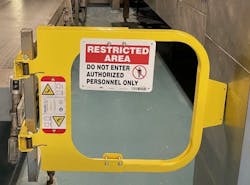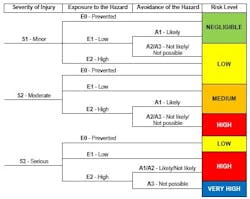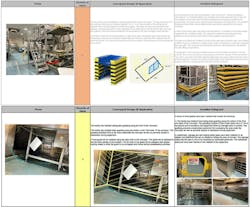
Machinery is an integral part of manufacturing as well as society overall. Due to this fact, machines and equipment are constantly being commissioned, upgraded and made more sophisticated. Additionally, older machines are reused, recommissioned and revitalized to work alongside the ever-expanding technologies in the market. Unfortunately, with old and new equipment alike, different regulatory guidelines and their interpretations allow for shortfalls in safety techniques, particularly safeguarding and risk reduction measures commonly referred to as “machine guarding.” These shortfalls in machine guarding pose potential hazards to facility personnel and end users. Inadequate safeguarding along with the implementation of workplace policies and procedures leads to workplace injury, regulatory penalties and operational disruptions.
Standards and regulations
Compliance with safety standards and regulations is the fundamental starting point for reducing risk and ensuring worker safety. The questions that always get brought up are which standard and regulation a facility should look at for guidance on machine safety and whose responsibility it is.
One consideration is the type of machine, as there are some specific standards that govern specific machine types. For instance, the Occupational Safety and Health Administration (OSHA) does not have specific regulations on industrial robots. However, they do have regulations on chemical exposure, working from heights, lockout/tagout, etc. The American National Standards Institute (ANSI) and the Associate for Advancing Automation (A3) have written, and recently updated, the ANSI/A3 R15.06 and ANSI/A3 R15.08 standards providing safety requirements for manufacturers, integrators, and end users of industrial robot systems.
Regarding U.S. safety regulations, OSHA is the agency responsible for writing and enforcing regulations that apply to most industries and that are considered mandatory by law. At the same time, as previously mentioned, there are not always OSHA regulations that cover the specific machine type. When that is the case, OSHA’s National Emphasis Programs (NEPs) and National Consensus Standards come into play. When OSHA does not have specific standards, such as for robot systems, they will often reference the safety consensus standards, and they have the power to cite observed safety violations on these machines through the General Duty Clause.
The importance of assessing risk
Understanding the risks posed by machinery is important not just to ensure a safe workplace and comply with safety regulations but as a sign of a manufacturing culture that sees compliance only as the starting point. Unfortunately, companies cannot assume that a machine, even one bought from a reputable supplier, is automatically “safe” for use in an industrial facility. Manufacturers and integrators of machinery in the U.S. are simply not able to know all the ins and outs of each facility and design their equipment to be inherently free of any hazards. However, working closely with original equipment manufacturers (OEMs) throughout the decision-making and design consideration processes can yield vast improvements in the design and implementation of systems. That is why assessing the risks within the facility-specific environment, operations and safety culture is such a vital step and is essential for knowing the risks posed to personnel and whether implemented safeguards are adequate.
Assessing machinery risks should be considered a part of the life cycle of a machine, starting with communication with the vendor or design team. When communicating with vendors, it is important to discuss risk and ask for a copy of any risk assessment or “residual risk” documentation they may have on the equipment or system. If possible, this request should be included in the Statement of Work (SOW). This may not always be possible, especially with older equipment.
Many facilities operate under the misconception that older machines are “grandfathered in” and do not require updated safety measures. This, however, does not typically hold true, particularly with employees and OSHA, as the potential risks are still present whether the machine was made 5 months ago or 5 decades ago. All equipment must comply with current safety regulations. When risk is assessed by a knowledgeable and diverse team with a site-specific context, it allows for the hazards and risks to be identified as what should be versus what actually is. This can then lead to the determination of the actual risks and the safest, most compliant and most feasible risk reduction measures needed to bring the machine to an agreed-upon acceptable level of risk.
Acceptable risk can be defined as a risk level achieved after implementing risk reduction measures, where the goal is to make the residual risk tolerable for a given task or hazard, but not necessarily zero risk, according to ANSI B11.0-2023.
Regarding the diversity of your risk assessment team, the following should be considered:
Facilitator/team lead: This person will lead the assessments, determine the goals and guidelines, specify the method for determining the risk (quantitative or qualitative), etc.
Diversity is important: Different people will have different views of safety and risk and come with their own biases of life, compliance and operations.
It is okay to disagree: Disagreement will help the team to discuss guidelines for what each characteristic stated below means and what level of risks can be deemed “Acceptable.” It is up to the team leader to work with the team members to come to a consensus.
Leverage a 3rd party if needed: A 3rd party comes with an extra level of expertise and an unbiased approach and resolution. They can facilitate the assessments of the hazards and the discussion and design of any necessary safeguards and risk reduction measures.
Risk assessment methodology
The key steps to conducting a risk assessment for a piece of machinery, also commonly referred to as a machine hazard analysis, job hazard analysis (JHA), or job safety analysis (JSA), include the following:
Step 1: Hazard identification. All foreseeable tasks and their associated hazards should be identified for the specific applications of the equipment. This includes identifying any affected personnel as well as the different stages within the life cycle of the machine (planning, procurement, operation/maintenance, disposal/renewal, etc.). The hazards equipment can pose include pinch points, rotating shafts, live electrical wiring, noise, heat, chemical or dust exposure, improper emergency stops, etc. An important note is to discuss all the different tasks associated with the equipment, even those that may not be routine (e.g. emergency conditions such as a sudden loss of power). Non-typical or hidden dangers from these tasks and conditions often introduce additional risks that may require specialized solutions.
Step 2: Risk level. With the tasks and hazards identified in Step 1, the next step is to establish what level of risk each hazard poses. The elements involved in risk determination include but are not limited to severity of harm and probability of occurrence.
Other elements can be added, and risk can be calculated quantitatively. Figure 1 shows one example of a risk level decision matrix used in multiple consensus standards.
Many risk assessment methodologies specify to assess hazards at first assuming no safeguards are installed at all, then again with the current safeguards (e.g. the methodologies identified in ISO 12100, ANSI/A3 R15.06, ANSI B11.0). However the team decides to assess risk, the important consideration is that the current safeguards be reviewed to determine their effectiveness. Are the current safeguards preventing access to the hazards and/or hazardous areas? Are they appropriate for the tasks being performed? Are they easily identified? Can they be defeated or bypassed?
Step 3: Risk reduction. After identifying and ranking the risks, the next step is to determine the appropriate risk reduction measures and safeguarding techniques that align with the level of risk and type of operations being performed by the machine and bring the risk to an acceptable level. This should be done with the team to decide the devices, administrative procedures, signage, etc. that would best serve to reduce exposure and risk. Included with the discussion of hardware and administrative practices is to compile a list of action plans and timelines for the implementation of the solutions decided upon.
When determining how to prioritize corrective actions related to the implementation of risk reduction measures, consider developing a ranking matrix based on the level of risk. Figure 2 shows an example ranking matrix.
Figure 3 shows real-world examples of machines that underwent risk assessments and the associated safeguards that were implemented. Note that the safeguards in the examples were part of a risk assessment process where a 3rd party consultant was utilized to determine the gaps in safety policies and safeguarding and who then prepared conceptual designs for the guards and fabricated the guards based on the findings of the risk assessment, in compliance with OSHA regulations, national consensus standards and industry best management practices.
Moving forward with safe machines
Assessing the risk of your machinery and implementing necessary safeguards and risk reduction measures is an ongoing process, with the risk assessment documents being live. This means that when processes, equipment, operations or the safety culture within your industry or facility change, it is essential to review the machines and safeguards to determine if they still produce an acceptable level of risk. This can be done through regular audits and inspections and using the members of the risk assessment team to bring personnel from their departments into the fold, which lets employees of all levels have a say and a stake in the safety of their fellow employees.
Prioritizing machine safety is crucial for protecting workers, ensuring compliance and maintaining productivity. There is no one-size-fits-all solution when it comes to assessing risk, effective safeguards and risk reduction measures, or even machine safety overall. It should be looked at based on the individual facility/company operations and culture. As technologies evolve, manufacturing operations change and the safety culture between facility personnel and upper management develops, the importance of regularly assessing hazards and effective risk reduction is of the utmost importance. Conducting thorough risk assessments, evaluating safeguard effectiveness and leveraging 3rd party expertise is vital to maintaining worker safety. By taking a proactive approach to assessing risk and machine safety and the implementation of machine-specific safeguarding and risk reduction solutions, facilities can create a safer, more productive workplace that reduces costs and fosters a culture of safety that benefits everyone involved.
About the Author

Adam Haroz
Adam Haroz is director of engineering at Conversion Technology, Inc., an environmental and safety consulting firm based in Norcross, GA.


